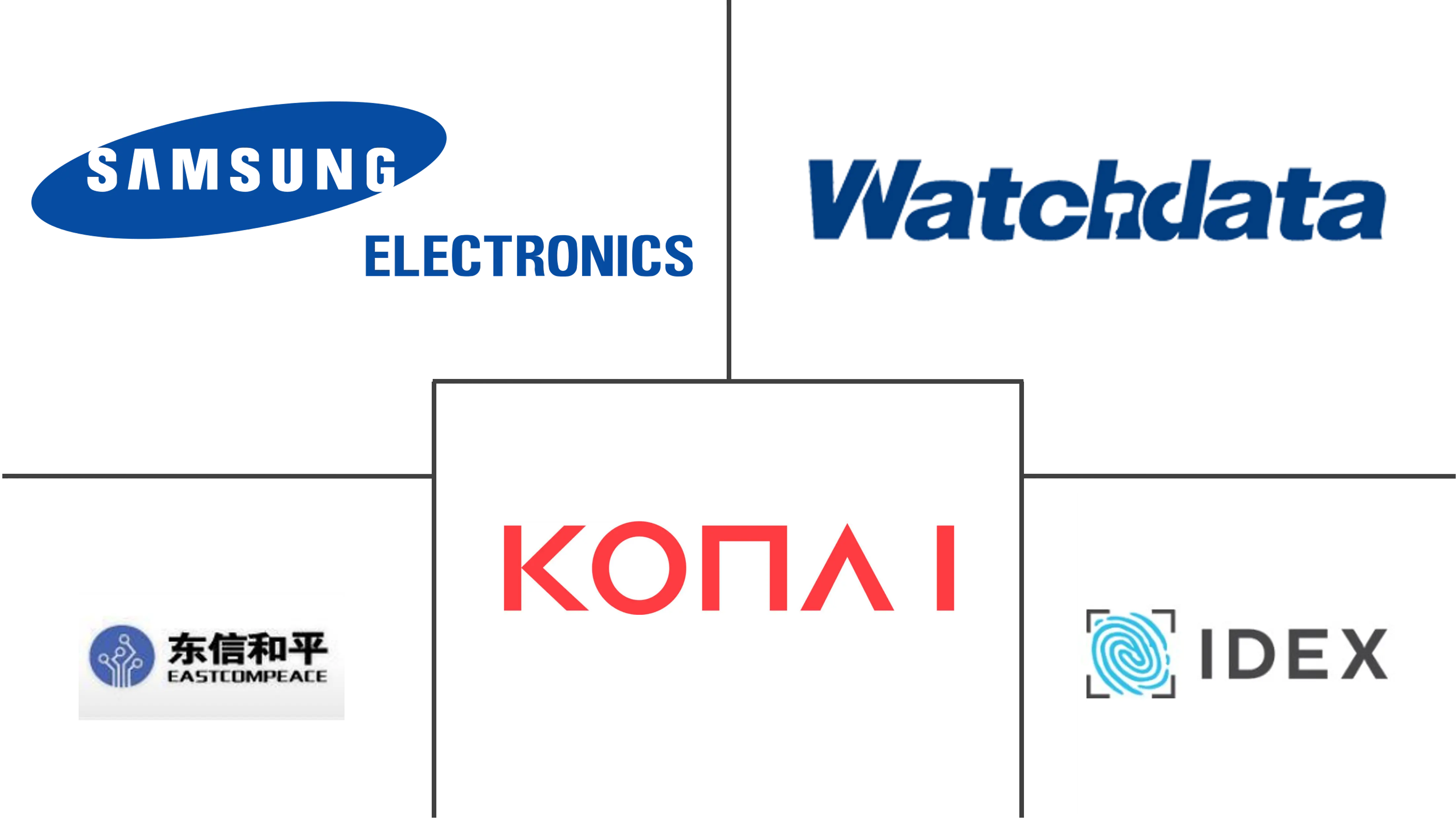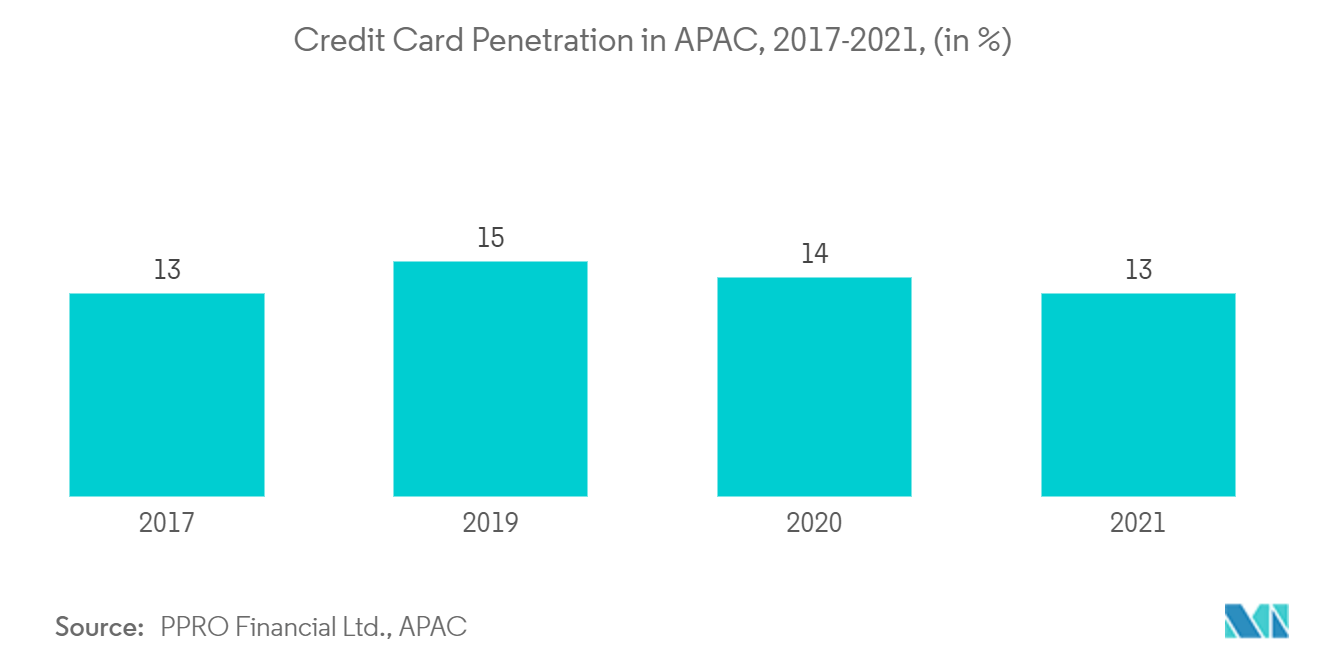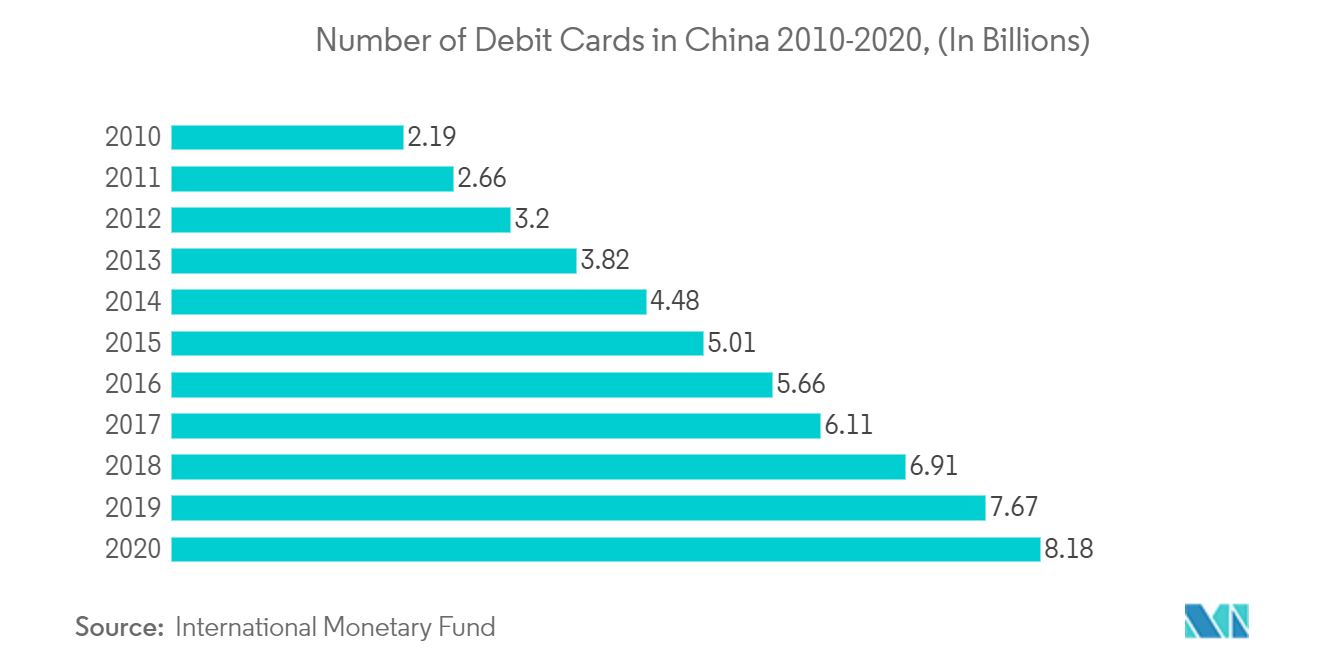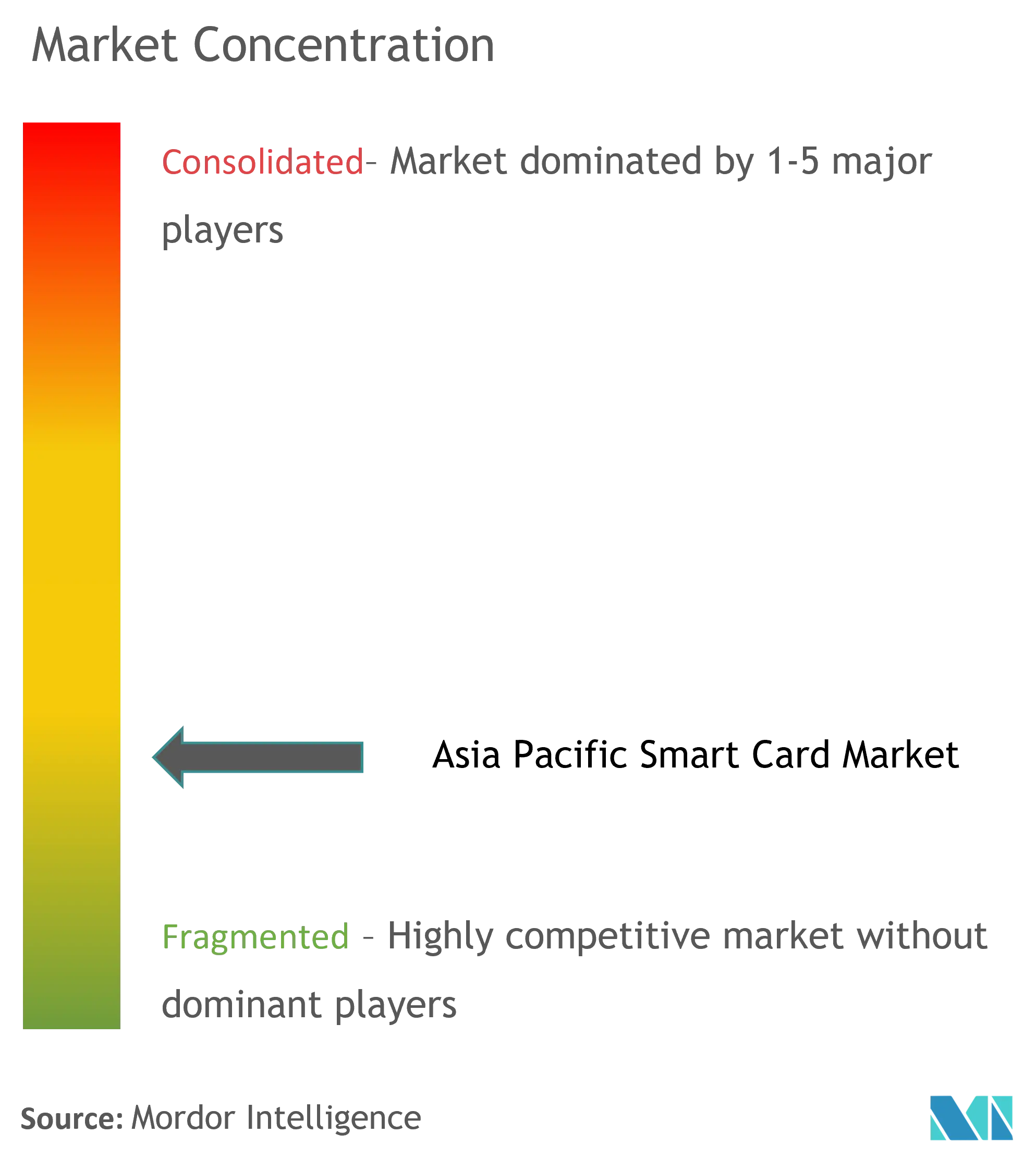APAC Smart Card Market Size

| Study Period | 2019 - 2029 |
| Base Year For Estimation | 2023 |
| Forecast Data Period | 2024 - 2029 |
| Historical Data Period | 2019 - 2022 |
| CAGR | 5.80 % |
| Market Concentration | Low |
Major Players
*Disclaimer: Major Players sorted in no particular order |
APAC Smart Card Market Analysis
During the forecast period of 2022-2027, the Asia-Pacific Smart Card Market is estimated to register a CAGR of 5.8%. Improvements in micro-embedded circuits and the growing acceptance of IoT technology drive the smart card business forward. Furthermore, the increasing use of gadgets packed with circuit chips that assist organizations in giving safer payment alternatives, data storage, and authentication to their users is driving the industry forward.
- The increasing digitalization of different government processes and the rising demand for identity cards necessary to access government services create new potential market opportunities. Along with that, the provision of healthcare, licenses, and social benefit documentation of people has resulted in government authorities' introduction of smart cards, hence accelerating the market's growth in the coming years.
- The growing trend of storing data effectively, shifting preferences toward contactless and cashless payments, and digitizing payment processes drive demand for smart cards in healthcare, retail, and hospitality. Additionally, blockchain technology's new customer information security technique and the widespread use of smart cards in the APAC region's most populous nation are projected to provide profitable growth possibilities for smart card producers.
- Also, security and miniaturization are two areas where smart card technology is evolving most quickly. With worldwide migration to higher security EMV banking cards, the newest generation of smart cards is capable of full on-chip cryptography, significantly increasing the security of cards across the industry. In addition, smart cards are increasingly miniaturized into more diverse form factors, such as mini-tags and smart wearables. These trends will continue as smart cards, along with phones or biometrics, are increasingly used as a two-factor credential.
- Additionally, Payment cards are, without even a doubt, essential in everyday life and business. According to the Smart Payment Association (SPA), about 90% of non-cash consumer payments in physical establishments are conducted with cards; in reality, payment cards are essential for obtaining cash. Furthermore, according to the SPA, payment cards facilitate 40-60% of online payments, either directly or indirectly.
- The increased need for a tap-and-pay payment method following the pandemic and the expanding acceptance of smart cards in various industries propel the market forward. Furthermore, high smart card penetration in access control and personal identification applications, rising need for smart cards to access e-government services, and rising demand for online shopping and banking drive smart card market growth throughout the forecast period.
- Furthermore, the COVID-19 pandemic is expected to boost market growth due to consumers' growing need for contactless payment methods worldwide. The expensive cost of implementing electronic point of sale system (EPOS) terminals and the expanding use of mobile wallets and payment applications are expected to limit smart card demand in the coming years.
APAC Smart Card Market Trends
This section covers the major market trends shaping the APAC Smart Card Market according to our research experts:
BFSI Sector will Hold Significant Share in Smart Card Deployment Across Asia Pacific
- Smart card usage in BFSI has several advantages, including personal data protection and secure transactions. Smart cards are also employed in the BFSI sector as credit or debit cards, payment authentication cards, and access control cards. It can be used as an electronic wallet by putting funds into the smart card, which can then be transferred using cryptographic protocols to a vending machine or an account.
- Furthermore, as technology progresses, the number of fraudulent operations has risen. As a result, the card and payments sector has undergone a digital transition, with new payment methods, including EMV chips, PIN cards, and mobile wallets, being introduced. Smart cards are gaining traction in the BFSI sector, owing to the difficulty decoding the data stored on them.
- For instance, in January 2021, StashFin, a Singapore-based neo banking start-up, teamed with SBM Bank India to develop a contactless prepaid card powered by VISA and equipped with an EMV chip that provides greater safety and security. The alliance aims to close the credit gap in India by giving underbanked individuals simple access to credit using smart cards.
- Biometric contactless smart cards will likely gain popularity in the BFSI industry over the forecast period, with various financial institutions recognizing the trend. Furthermore, because critical financial operations are at the heart of a business, security is always a top priority. IDEMIA, for example, is advancing the evolution of smart cards by utilizing biometric technologies.
- Similarly, in February 2021, ICICI Bank announced the 'Namma Chennai Smart Card' launch in collaboration with Greater Chennai Corporation and Chennai Smart City Limited. This Rupay-powered co-branded contactless prepaid card at GCC centers would enable various digital payments such as tax and utility bills. The prepaid card can also be used to make retail payments in Chennai, India, and in retail outlets and e-commerce websites around the country.

China will Dominate Smart Card Growth in Asia Pacific
- China was one of the first countries to phase out checks in favor of contactless payments, which led to the developing of digital cards across Asia. The country has implemented smart cards in various industries, including transportation. Since the Chinese government has encouraged industry consolidation to control the industry and improve competitiveness in the global market, rapid consolidation between medium-sized and big businesses is expected.
- In addition, numerous Chinese banks are working on digital yuan hard wallets, and the People's Bank of China has indicated that clients will be able to hold digital currency in both physical and digital wallets. The People's Bank of China (PBOC) has expanded its central bank digital currency (CBDC) trial to include a contactless "hard wallet" and NFC wearables that allow customers to use their digital yuan to pay for goods and services in stores and on public transportation.
- For instance, China Construction Bank stated in June 2021 that it would be testing a biometric 'hard wallet' smart card that would allow clients to store digital yuan and confirm payments made using the central bank's digital currency using their fingerprint. Advanced fingerprint recognition and authentication are used to secure the card's stored value.
- In addition, IDEX Biometrics ASA stated in November 2021 that China UnionPay had approved the latest biometric smart card from its solution partner Hengbao Corporation Ltd for certification (CUP). The new card, which uses IDEX Biometrics' sensor and biometric software solution, passed all China's Bank Card Test Center's requirements (BCTC). This smart card will all be possible with multi-use applications, secure global payments, and additional capabilities such as access control and personal identification.

APAC Smart Card Industry Overview
Several worldwide and regional firms compete for market share in the Asia Pacific smart card market, which is highly competitive. Despite the market's high barriers to entry for new competitors, a few newcomers have achieved traction. Moderate/high product differentiation, increasing product penetration levels, and high competition levels characterize this market. The solutions are usually sold as a bundle, making the condensed offering appear part of the whole suite.
- June 2022 - Wisecard Technology and Zwipe are set to unveil their collaboration to provide biometric payment cards to consumers of Asia Pacific (APAC). Wisecard will supply pre-built customization scripts for Zwipe Pay biometric payment cards, allowing banks and card personalization bureaus to install the cards significantly quicker and more effectively.
- January 2022 - Samsung Electronics Co., Ltd., a global leader in innovative semiconductor technology, has unveiled the S3B512C, a new fingerprint security IC (integrated circuit) with improved security features. The new system is EMVCo and CC EAL 6+ certified, and it meets Mastercard's latest Biometric Evaluation Plan Summary (BEPS) criteria for biometric payment cards.
APAC Smart Card Market Leaders
-
Samsung Electronics Co. ltd.
-
Watchdata Co., Ltd.
-
KONA I Co., Ltd.
-
Eastcompeace Technology Co., Ltd
-
IDEX Biometrics ASA
*Disclaimer: Major Players sorted in no particular order

APAC Smart Card Market News
- January 2022 - MKSmart, a provider of smart card solutions for financial payments, access control, and government identification in Southeast Asia, has signed a development agreement with IDEX Biometrics ASA. As a result of this agreement, banks and other payment card issuers will be able to use biometric smart cards with industry-leading performance and cost-effective solutions.
- November 2021 - Mastercard has teamed up with three Asian digital asset platforms to launch payment cards that allow consumers to exchange bitcoin and other cryptocurrencies into fiat currencies. In the Asia Pacific, the alliance plans to launch cryptocurrency-linked credit, debit, and prepaid cards for both consumers and companies.
- June 2021 - Mumbai Metro One, Axis Bank, and RuPay have launched the 'ONE MUMBAI' Smart Card in India, allowing individuals to travel in a contactless and cashlessly. Its goal is to give Mumbai citizens a convenient, cashless, and contactless mode of transportation.
APAC Smart Card Market Report - Table of Contents
1. INTRODUCTION
1.1 Study Assumptions and Market Definition
1.2 Scope of the Study
2. RESEARCH METHODOLOGY
3. EXECUTIVE SUMMARY
4. MARKET INSIGHTS
4.1 Market Overview
4.2 Industry Attractiveness - Porter's Five Forces Analysis
4.2.1 Threat of New Entrants
4.2.2 Bargaining Power of Buyers
4.2.3 Bargaining Power of Suppliers
4.2.4 Threat of Substitute Products
4.2.5 Intensity of Competitive Rivalry
4.3 Industry Value Chain Analysis
4.4 Impact of COVID-19 on the Market
5. MARKET DYNAMICS
5.1 Market Drivers
5.1.1 Smart Cards are Being Extensively Used in Access Control and Personal Identification Applications
5.1.2 Growing Demand for Contactless Payments
5.2 Market Challenges
5.2.1 Privacy and Security Issues and Standardization Concerns
5.2.2 Emergence of Mobile Wallets Impacting Demand for Smart Cards
6. MARKET SEGMENTATION
6.1 Type
6.1.1 Contact-based
6.1.2 Contact-less
6.2 End-User
6.2.1 BFSI
6.2.2 IT and Telecommunication
6.2.3 Government
6.2.4 Transportation
6.2.5 Other End-user Industries (Education, Healthcare, Entertainment, etc.)
6.3 Country
6.3.1 China
6.3.2 Japan
6.3.3 India
6.3.4 South Korea
6.3.5 Rest of Asia-Pacific
7. COMPETITIVE LANDSCAPE
7.1 Company Profiles
7.1.1 Samsung Electronics Co. ltd.
7.1.2 Watchdata Co., Ltd.
7.1.3 KONA I Co., Ltd.
7.1.4 Eastcompeace Technology Co., Ltd
7.1.5 IDEX Biometrics ASA
7.1.6 Seshaasai Business Forms Pvt Ltd.
7.1.7 Advanced Card Systems Ltd. (ACS)
7.1.8 Pura Group
7.1.9 Asia Credit Card Production Ltd.
7.1.10 Thales Group
7.1.11 Assa Abloy AB
7.1.12 IDEMIA SAS (Advent International, Inc.)
- *List Not Exhaustive
8. INVESTMENT ANALYSIS
9. FUTURE MARKET OUTLOOK
APAC Smart Card Industry Segmentation
A smart card is a physical authorization device with an embedded computer chip that enables it to store and transact data. Smart cards are primarily targeted toward applications that require high-security requirements such as authentication, identification, data storage, and application processing. The study considers contact-based and contactless smart card products. However, hybrid and dual interface solutions, which host a combination of contact and contactless technologies, are not considered part of the study.
All market estimates presented in the report are the most recent findings and estimates and are adjusted per the COVID-19 impact on the market studied.
| Type | |
| Contact-based | |
| Contact-less |
| End-User | |
| BFSI | |
| IT and Telecommunication | |
| Government | |
| Transportation | |
| Other End-user Industries (Education, Healthcare, Entertainment, etc.) |
| Country | |
| China | |
| Japan | |
| India | |
| South Korea | |
| Rest of Asia-Pacific |
APAC Smart Card Market Research FAQs
What is the current Asia Pacific Smart Card Market size?
The Asia Pacific Smart Card Market is projected to register a CAGR of 5.80% during the forecast period (2024-2029)
Who are the key players in Asia Pacific Smart Card Market?
Samsung Electronics Co. ltd., Watchdata Co., Ltd., KONA I Co., Ltd., Eastcompeace Technology Co., Ltd and IDEX Biometrics ASA are the major companies operating in the Asia Pacific Smart Card Market.
What years does this Asia Pacific Smart Card Market cover?
The report covers the Asia Pacific Smart Card Market historical market size for years: 2019, 2020, 2021, 2022 and 2023. The report also forecasts the Asia Pacific Smart Card Market size for years: 2024, 2025, 2026, 2027, 2028 and 2029.
Asia Pacific Smart Card Industry Report
Statistics for the 2024 Asia Pacific Smart Card market share, size and revenue growth rate, created by Mordor Intelligence™ Industry Reports. Asia Pacific Smart Card analysis includes a market forecast outlook 2029 and historical overview. Get a sample of this industry analysis as a free report PDF download.



